"A Look to the Heavens" -- Trifid Nebula
Apr 27, 2017 10:36:32 #
"A Look to the Heavens"
Posted: 26 Apr 2017 03:22 PM PDT
“Clouds of glowing gas mingle with dust lanes in the Trifid Nebula, a star forming region toward the constellation of the Archer (Sagittarius). In the center, the three prominent dust lanes that give the Trifid its name all come together. Mountains of opaque dust appear on the right, while other dark filaments of dust are visible threaded throughout the nebula. A single massive star visible near the center causes much of the Trifid's glow.
http://2.bp.blogspot.com/-4QMOxM6vygQ/UQh8HzpWhWI/AAAAAAABE0E/gg-oC_wVchI/s1600/trifid_gendler_960.jpg
The Trifid, also known as M20, is only about 300,000 years old, making it among the youngest emission nebulae known. The nebula lies about 9,000 light years away and the part pictured here spans about 10 light years. The above image is a composite with luminance taken from an image by the 8.2-m ground-based Subaru Telescope, detail provided by the 2.4-m orbiting Hubble Space Telescope, color data provided by Martin Pugh and image assembly and processing provided by Robert Gendler.”
- http://apod.nasa.gov/apod/ap130128.html
Posted: 26 Apr 2017 03:22 PM PDT
“Clouds of glowing gas mingle with dust lanes in the Trifid Nebula, a star forming region toward the constellation of the Archer (Sagittarius). In the center, the three prominent dust lanes that give the Trifid its name all come together. Mountains of opaque dust appear on the right, while other dark filaments of dust are visible threaded throughout the nebula. A single massive star visible near the center causes much of the Trifid's glow.
http://2.bp.blogspot.com/-4QMOxM6vygQ/UQh8HzpWhWI/AAAAAAABE0E/gg-oC_wVchI/s1600/trifid_gendler_960.jpg
The Trifid, also known as M20, is only about 300,000 years old, making it among the youngest emission nebulae known. The nebula lies about 9,000 light years away and the part pictured here spans about 10 light years. The above image is a composite with luminance taken from an image by the 8.2-m ground-based Subaru Telescope, detail provided by the 2.4-m orbiting Hubble Space Telescope, color data provided by Martin Pugh and image assembly and processing provided by Robert Gendler.”
- http://apod.nasa.gov/apod/ap130128.html
Apr 27, 2017 13:17:41 #
pafret wrote:
"A Look to the Heavens" br br Posted: 2... (show quote)
One thing most people don't know is that those colors are artificial. This is not what it looks like, viewed through a telescope. Still, it looks pretty awesome.
Apr 27, 2017 13:56:49 #
pafret wrote:
"A Look to the Heavens" br br Posted: 2... (show quote)
Sure is a beauty to behold... The reflective light sure allows us to see its density..
Also, my sun sign is Sagittarius.. So you know I've added this one with the others you post for us...
Thank You...
Adding a couple as seen through a telescope and one that is a sketch of it as seen through a telescope..Simply spectacular!!
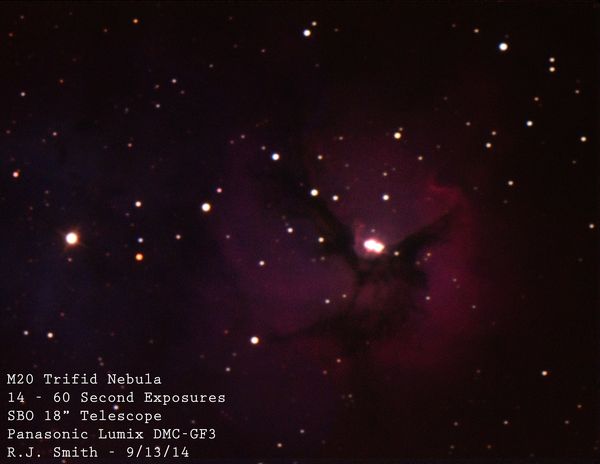
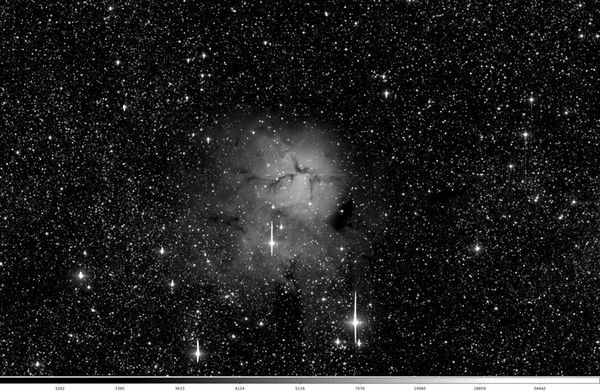
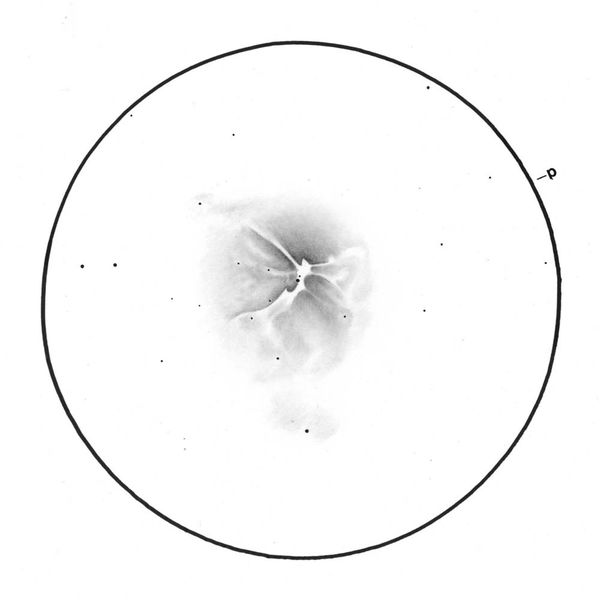
Apr 27, 2017 14:10:50 #
Mr Bombastic wrote:
One thing most people don't know is that those colors are artificial. This is not what it looks like, viewed through a telescope. Still, it looks pretty awesome.
The colors are due to the use of filters which permit other parts of the light spectrum to be displayed (infrared through X-Ray) and are usually composites of several exposures. Lindajoy posted some nice shots of the same area which have not been color enhanced. While an astronomer would be satisfied with the black and white photos, the color shifted versions are gorgeous art.
Apr 27, 2017 14:25:01 #
How about this ?? Have you seen it yet?? Found 2011....
Scientists Discover The Oldest, Largest Body Of Water In ExistenceâIn Space
Scientists Discover The Oldest, Largest Body Of Water In ExistenceâIn Space
Around a black hole 12 billion light years away, thereâs an almost unimaginable vapor cloud of waterâenough to supply an entire planetâs worth of water for every person on earth, 20,000 times over.
Scientists have found the biggest and oldest reservoir of water everâso large and so old, itâs almost impossible to describe.
The water is out in space, a place we used to think of as desolate and desert dry, but itâs turning out to be pretty lush.
Researchers found a lake of water so large that it could provide each person on Earth an entire planetâs worth of waterâ20,000 times over. Yes, so much water out there in space that it could supply each one of us all the water needed..
The official NASA news release describes the amount of water as â140 trillion times all the water in the worldâs oceans,â which isnât particularly helpful, except if you think about it like this.
That one cloud of newly discovered space water vapor could supply 140 trillion planets that are just as wet as Earth is.
Mind you, our own galaxy, the Milky Way, has about 400 billion stars, so if every one of those stars has 10 planets, each as wet as Earth, thatâs only 4 trillion planets worth of water.
The new cloud of water is enough to supply 28 galaxies with water.
Truly, that is one swampy patch of intergalactic space.
Scientists Discover The Oldest, Largest Body Of Water In ExistenceâIn Space
Scientists Discover The Oldest, Largest Body Of Water In ExistenceâIn Space
Around a black hole 12 billion light years away, thereâs an almost unimaginable vapor cloud of waterâenough to supply an entire planetâs worth of water for every person on earth, 20,000 times over.
Scientists have found the biggest and oldest reservoir of water everâso large and so old, itâs almost impossible to describe.
The water is out in space, a place we used to think of as desolate and desert dry, but itâs turning out to be pretty lush.
Researchers found a lake of water so large that it could provide each person on Earth an entire planetâs worth of waterâ20,000 times over. Yes, so much water out there in space that it could supply each one of us all the water needed..
The official NASA news release describes the amount of water as â140 trillion times all the water in the worldâs oceans,â which isnât particularly helpful, except if you think about it like this.
That one cloud of newly discovered space water vapor could supply 140 trillion planets that are just as wet as Earth is.
Mind you, our own galaxy, the Milky Way, has about 400 billion stars, so if every one of those stars has 10 planets, each as wet as Earth, thatâs only 4 trillion planets worth of water.
The new cloud of water is enough to supply 28 galaxies with water.
Truly, that is one swampy patch of intergalactic space.
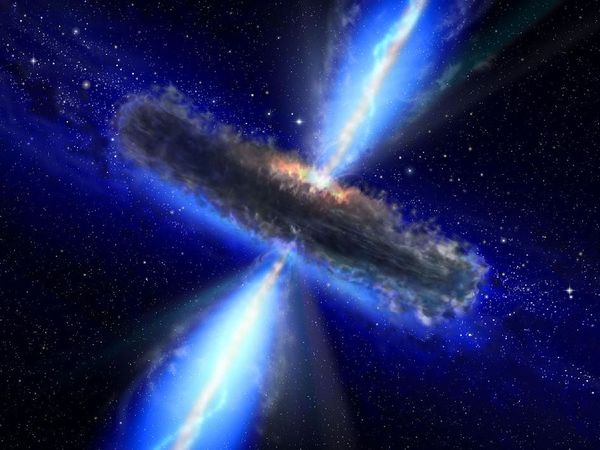
Apr 27, 2017 14:27:55 #
lindajoy wrote:
How about this ?? Have you seen it yet?? Found 201... (show quote)
And you have to ask yourself. How did all that water get there? I think God PUT it there. Just to say hello. I'm here.
Apr 27, 2017 14:30:13 #
lindajoy wrote:
How about this ?? Have you seen it yet?? Found 201... (show quote)
Another question. Water is a combination of oxygen and hydrogen. Space is pretty cold. How did frozen oxygen and frozen hydrogen combine to create frozen water?
Apr 27, 2017 14:34:05 #
pafret wrote:
The colors are due to the use of filters which permit other parts of the light spectrum to be displayed (infrared through X-Ray) and are usually composites of several exposures. Lindajoy posted some nice shots of the same area which have not been color enhanced. While an astronomer would be satisfied with the black and white photos, the color shifted versions are gorgeous art.
Ok, here's one I kept..
I liked its name~~
This 1995 Hubble Space Telescope image of the 'Pillars of Creation' is probably the most famous astronomical image of the 20th Century. Taken in visible light using a combination of SII/H-alpha and OIII filters, it shows a part of the Eagle Nebula where new stars are forming. The tallest pillar is around 4 light-years high.
Credit: NASA/ESA/STScI, Hester & Scowen (Arizona State University)
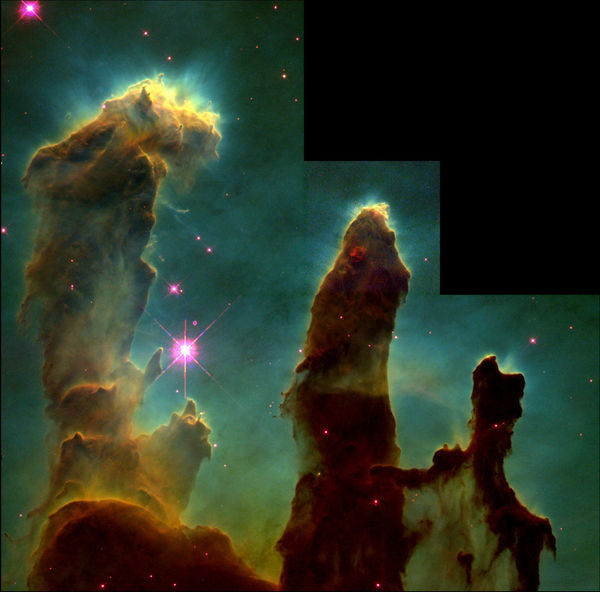
Apr 27, 2017 14:45:49 #
Mr Bombastic wrote:
And you have to ask yourself. How did all that water get there? I think God PUT it there. Just to say hello. I'm here.
I think he did as well...Knowing Him, there is likely multiple purposes too...Like to let that water vapor slowly release and reform just as does everything in the Universe, including planets but damn don't tell the alarmists~~
Apr 27, 2017 14:50:38 #
Mr Bombastic wrote:
Another question. Water is a combination of oxygen and hydrogen. Space is pretty cold. How did frozen oxygen and frozen hydrogen combine to create frozen water?
Apr 28, 2017 10:36:55 #
Great question but allow me to be trite. It was obviously during an Al Gore moment of universe warming, er, I mean, universe c*****e c****e. Way to go, Al!
A bit more seriously. Do not valence electrons still allow for molecule creation regardless of temperature? I'm guessing outer space approximates absolute zero so molecules/atoms don't move around but I can cite no reason why molecules couldn't be formed. I bow to anyone who has an answer.
A bit more seriously. Do not valence electrons still allow for molecule creation regardless of temperature? I'm guessing outer space approximates absolute zero so molecules/atoms don't move around but I can cite no reason why molecules couldn't be formed. I bow to anyone who has an answer.
Apr 28, 2017 12:38:37 #
EN Submarine Qualified wrote:
Great question but allow me to be trite. It was obviously during an Al Gore moment of universe warming, er, I mean, universe c*****e c****e. Way to go, Al!
A bit more seriously. Do not valence electrons still allow for molecule creation regardless of temperature? I'm guessing outer space approximates absolute zero so molecules/atoms don't move around but I can cite no reason why molecules couldn't be formed. I bow to anyone who has an answer.
A bit more seriously. Do not valence electrons still allow for molecule creation regardless of temperature? I'm guessing outer space approximates absolute zero so molecules/atoms don't move around but I can cite no reason why molecules couldn't be formed. I bow to anyone who has an answer.
I'm no scientist, but it doesn't seem possible that molecular interactions could happen at such extreme temperatures. And why is all of that water in one spot? If the big bang were true, those water molecules would be spread out all over the place. But there they are. The Bible speaks about signs and wonders in the Heavens, during the end times. Perhaps this is one of them. Gods way of saying I'm here.
Apr 28, 2017 12:49:10 #
Mr Bombastic wrote:
Another question. Water is a combination of oxygen and hydrogen. Space is pretty cold. How did frozen oxygen and frozen hydrogen combine to create frozen water?
What's the Temperature of Outer Space?
455 degrees Fahrenheit
Some parts of space are hot! Gas between stars, as well as the solar wind, both seem to be what we call "empty space," yet they can be more than a thousand degrees, even millions of degrees. However, there's also what's known as the cosmic background temperature, which is minus 455 degrees Fahrenheit.
At the physically impossible-to-reach temperature of zero kelvin, or minus 459.67 degrees Fahrenheit (minus 273.15 degrees Celsius), atoms would stop moving. As such, nothing can be colder than absolute zero on the Kelvin scale.
That cloud of water vapor is obviously getting energy from something, at the background temperature of space it would be ice crystals, not vapor. It needed energy to go from solid to liquid to vapor and to maintain the vapor state.
Apr 28, 2017 13:19:37 #
pafret wrote:
What's the Temperature of Outer Space? br br 455... (show quote)
Maybe. It also looks like that cloud has a neutron star inside it, or wh**ever that thing is called. But the edges of that cloud are probably millions, if not billions of miles away from it. is that close enough for radiant heat to do the job? And there is still the question of just WTF all that water came from. I don't believe that there are any cosmic models of inflation that can explain it. That's OK. I'm good with mystery.
Apr 28, 2017 14:05:00 #
pafret wrote:
What's the Temperature of Outer Space? br br 455... (show quote)
Love the discussion. Got s little problem with heat. I believe it is a measure of molecular notion. No molecules wiggling around, no heat. Even in a sparse environment limited molecules means limited heat. I guess we have to get into specific heat of wh**ever molecules might be present to determine how much heat there is and then we might be able to calculate temperature.
Our old buddies, Messrs. Keenan and Keyes in their book "Properties of Saturated Steam" covered the situation of melting and evaporation well for atmosphere based environment. Wonder what a steam table would look like for conditions in outer space.
If you want to reply, then register here. Registration is free and your account is created instantly, so you can post right away.



